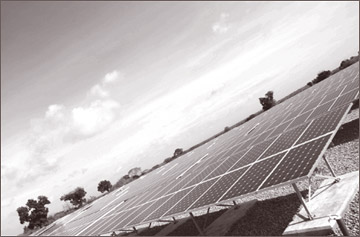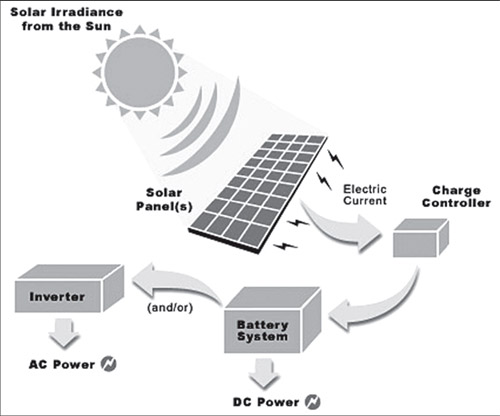Solar power as a safe investment
M Bertie Perera - Chartered Engineer
It was reported in the newspapers that solar power is to be developed
to have 20 percent of the total power supply from solar by 2020. This
means an addition of about 500 MW of solar power in about ten years
time.
|

Using solar power to meet global energy needs. File photo |
Whereas in Australia 20 percent of the total power will be from solar
and wind power amounting to 8,000 MW in 2020. By helping the consumer
with 50 percent of its cost, the scheme has already started as it is so
beneficial for the consumers, supply authorities and the environment.
Since, I have first-hand information in this scheme, I would like to
point out that in Australia it has been planned to install the panels on
the roofs as a standard system to generate 1.6 KW as it is very costly
to mount them on structures when erecting on land. Further, when the
cost or lease of land is added, the cost of generating from solar power
will become more costly.
Power supply
When I got this standard system of 1.6 KW installed on my roof in
Australia, the whole set up was estimated to cost only $ (Aus) 6,000.
This consists of seven solar panels and they covered only a small area
of the roof. The installation was so simple it took only about four
hours to complete the installation including the switch gear, inverter
etc. and then connect to the household power supply. Immediately on
completion it started to generate electricity making the disk in the
house service metre to run in the opposite direction whenever the
household demand for power was less than that generated by the panels.
Thereafter, in a few weeks a special metre was installed to replace the
house service metre to indicate separately the power imported and
exported.
Market price
The Australian government is so generous in this scheme and they paid
me $ 3,000 being 50 percent of the total cost and now the supply
authorities pay me $ .52 for every unit I export while I pay $ 0.19 for
a unit I import. The last three months bill I received, which covers
only a part of the time that solar was in operation, was $ 123 credit,
which means they owe me $ 123. The average amount of electricity
generated works to 230 units a month. In Sri Lanka, where the cost of
labour and the profit on materials are much less, the whole system will
not cost more than $ 5,000 or approximately Rs 500,000. Since these
panels carry a guarantee of 25 years from the manufacturers, the cost of
a unit will come to only Rs 8 as this standard set up will generate an
average of about 200 units of electricity a month taking the cloudy days
of the year into account.
 |
An average household in Sri Lanka needs only about 100 units a month
and the consumer will be in a position to sell to the grid 100 units a
month. Since this could continue for 25 years there is no need to worry
about the rise in the cost of electricity for 25 years as the entire
energy input is directly from the sun. Hence, when the market price of
electricity generated from other sources goes up the solar power can be
sold at a higher price. Thus, in about 10 years, the consumer will be
able to earn virtually the entire monthly installment payment if the
total amount of Rs 500,000 is burrowed to pay back in 20 years at very
low interest that are normally available for carbon emission free power
generation projects. Additionally, carbon saving certificates too can be
sold to bring the monthly installment under Rs 2,000. Furthermore, the
cost of first 100 units will come down gradually to zero as the market
price increases. When the loan is fully settled in 20 years, the income
that will be generated will be sufficient to replace the panels to have
free electricity and also an income.
Hence, I strongly suggest that the government should go ahead with a
project of installing solar panels by obtaining a low interest loan from
an international fund, utilizing the roof structures of one million
households to start with, as a project giving the consumers the
opportunity of paying this back as a safe investment for them. Even
private investors can invest by paying a lease for the roofs. When the
consumers invest, the system can be connected directly to the household
supply and when the others install panels by leasing the roof they can
connect through another metre to the grid before coming to the
consumer's service metre on a contract with the supply authorities, to
supply electricity to the grid.
Distribution network
Thus, at 1.6 KW per household, 1,600 MW can be added to the grid in a
couple of years with the advantage of having the benefits from day one
of the installation. This will not eat into the base load that coal
plants are feeding as the day time load which includes industrial and
commercial mostly, is sufficient to be fed from coal and solar as well
keeping hydro in reserve to work only in the night supported by the coal
plants. Since, solar power gets distributed throughout the distribution
network, even cooking from electricity during the daytime is possible
without upgrading the network if the panels are spread out according to
the load demands. Thus, sufficient load can be developed to increase the
base load so that the coal plants too can be operated most efficiently.
With a small modification to the hydro system to include a pumping
arrangement during day time utilizing excess power from solar and coal,
the power supply can be made not only to meet the increasing demand but
also as an investment to tap freely available sunshine at our doorstep. |



